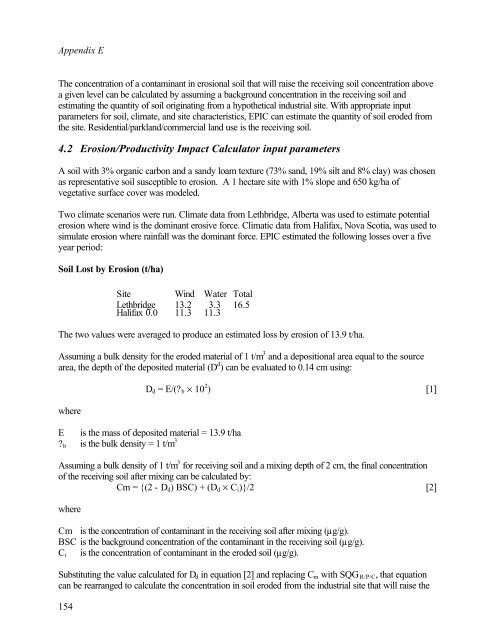Protocol for the Derivation of Environmental and Human ... - CCME
Protocol for the Derivation of Environmental and Human ... - CCME
Protocol for the Derivation of Environmental and Human ... - CCME
Create successful ePaper yourself
Turn your PDF publications into a flip-book with our unique Google optimized e-Paper software.
Appendix E<br />
The concentration <strong>of</strong> a contaminant in erosional soil that will raise <strong>the</strong> receiving soil concentration above<br />
a given level can be calculated by assuming a background concentration in <strong>the</strong> receiving soil <strong>and</strong><br />
estimating <strong>the</strong> quantity <strong>of</strong> soil originating from a hypo<strong>the</strong>tical industrial site. With appropriate input<br />
parameters <strong>for</strong> soil, climate, <strong>and</strong> site characteristics, EPIC can estimate <strong>the</strong> quantity <strong>of</strong> soil eroded from<br />
<strong>the</strong> site. Residential/parkl<strong>and</strong>/commercial l<strong>and</strong> use is <strong>the</strong> receiving soil.<br />
4.2 Erosion/Productivity Impact Calculator input parameters<br />
A soil with 3% organic carbon <strong>and</strong> a s<strong>and</strong>y loam texture (73% s<strong>and</strong>, 19% silt <strong>and</strong> 8% clay) was chosen<br />
as representative soil susceptible to erosion. A 1 hectare site with 1% slope <strong>and</strong> 650 kg/ha <strong>of</strong><br />
vegetative surface cover was modeled.<br />
Two climate scenarios were run. Climate data from Lethbridge, Alberta was used to estimate potential<br />
erosion where wind is <strong>the</strong> dominant erosive <strong>for</strong>ce. Climatic data from Halifax, Nova Scotia, was used to<br />
simulate erosion where rainfall was <strong>the</strong> dominant <strong>for</strong>ce. EPIC estimated <strong>the</strong> following losses over a five<br />
year period:<br />
Soil Lost by Erosion (t/ha)<br />
154<br />
Site Wind Water Total<br />
Lethbridge 13.2 3.3 16.5<br />
Halifax 0.0 11.3 11.3<br />
The two values were averaged to produce an estimated loss by erosion <strong>of</strong> 13.9 t/ha.<br />
Assuming a bulk density <strong>for</strong> <strong>the</strong> eroded material <strong>of</strong> 1 t/m 3 <strong>and</strong> a depositional area equal to <strong>the</strong> source<br />
area, <strong>the</strong> depth <strong>of</strong> <strong>the</strong> deposited material (D d ) can be evaluated to 0.14 cm using:<br />
where<br />
D d = E/(? b × 10 2 ) [1]<br />
E is <strong>the</strong> mass <strong>of</strong> deposited material = 13.9 t/ha<br />
? b is <strong>the</strong> bulk density = 1 t/m 3<br />
Assuming a bulk density <strong>of</strong> 1 t/m 3 <strong>for</strong> receiving soil <strong>and</strong> a mixing depth <strong>of</strong> 2 cm, <strong>the</strong> final concentration<br />
<strong>of</strong> <strong>the</strong> receiving soil after mixing can be calculated by:<br />
Cm = {(2 - D d ) BSC) + (D d × C i )}/2 [2]<br />
where<br />
Cm is <strong>the</strong> concentration <strong>of</strong> contaminant in <strong>the</strong> receiving soil after mixing (µg/g).<br />
BSC is <strong>the</strong> background concentration <strong>of</strong> <strong>the</strong> contaminant in <strong>the</strong> receiving soil (µg/g).<br />
C i is <strong>the</strong> concentration <strong>of</strong> contaminant in <strong>the</strong> eroded soil (µg/g).<br />
Substituting <strong>the</strong> value calculated <strong>for</strong> D d in equation [2] <strong>and</strong> replacing C m with SQG R/P/C, that equation<br />
can be rearranged to calculate <strong>the</strong> concentration in soil eroded from <strong>the</strong> industrial site that will raise <strong>the</strong>
















